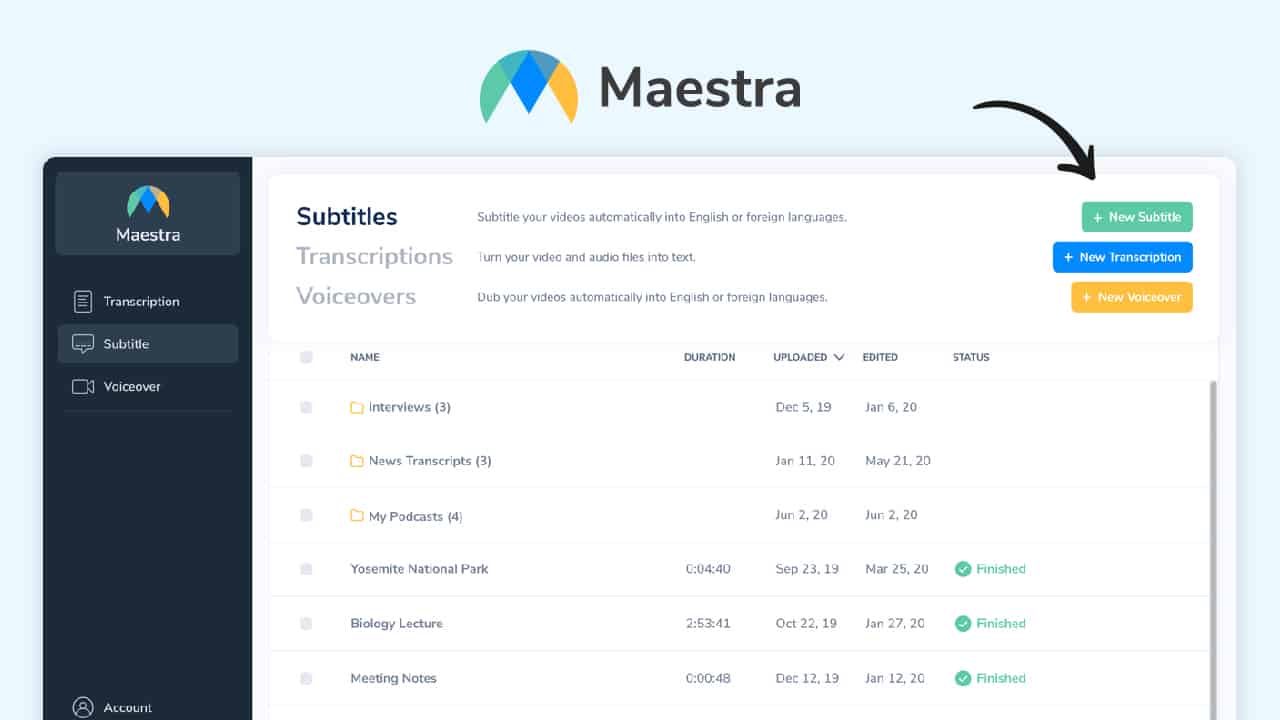How To Add Captions To Social Media Videos to Boost Engagement & Reach

For so long, we have heard that visual media like video speaks for itself and often captures attention better than any other form of media. In some respects, this is certainly true. People tend to share videos more readily than they share large blocks of text. In fact, one report found that people share videos 1200% more often than text and image-based content.
Of course, video is not without its limitations. Sometimes people are just not in the right environment to sit through lengthy videos. Other times, people have disabilities that make watching videos all the way through difficult.
This is where captions come into play.
In this article, we will look at why captions are such a powerful tool and why you should consider including them in your videos.
What Are Captions?
To put it simply, captions are conversions of audio content into text. A screen displays the text, which allows viewers to read what is spoken on screen while still engaging with the video itself.
Open and closed captioning is available to audiences. Captions supplement audio with information related to the context of the story on the television. Audiences can turn closed captions off, but open captions cannot be turned off. Captions on social media platforms are often open captions.
Should You Add Captions To Your Videos?
According to the NIDCD (National Institute on Deafness and Other Communication Disorders), there are presently 37 million adults in the US who have trouble hearing. Meanwhile, video has become such a popular platform for sharing information, learning, and marketing. In fact, it is estimated that roughly 86% of all businesses take advantage of video to market their products.
Needless to say, if you are creating videos on several social media platforms, then you need to add captions to your videos. But it is not just those with hearing problems who benefit from captioned videos.
Sometimes, people just find that captions make it easier to follow along with a video. One study published with the EduCause Review found that around 90% of students found captions to be “at least moderately helpful while learning.” You may not be trying to teach a complicated Chemistry course or give a college-level Philosophy lecture; even so, these numbers reveal that people value captions. As such, they are worth embracing.
Still not convinced? Below, we will go into greater detail about these benefits.
Benefits Of Adding Captions To Social Media
Video captions do not only benefit viewers but creators as well. Brand identity and advertising revenue will both improve if creators add captions to their videos. Making this simple change to your videos will help creators become more successful in their professional lives.
Captions are used on Facebook, Instagram, Twitter, and other social media platforms. All users should understand the benefits of captioning and how it can increase productivity and sales. If businesses are using social media platforms to sell products, then they need to understand how to incorporate captions to appeal to wider audiences around the world.
Bottom line: captions make your videos easier to consume. This in turn helps you improve in the following areas:
Benefit #1: SEO Benefit Of Captions
First, adding captions will improve search engine optimization metrics. By their very nature, videos simply do not have text; visitors to your website have to press play to hear what you have to say. While this is a great way to engage potential customers, it may leave you wondering how search engines can rank you. After all, that’s all text-based.
Fortunately, captions can bridge the gap between practicality (ranking on search engines) and engagement (providing worthwhile content that people want to see). Just by capitalizing on captions, you can increase revenue by 16%. That’s because transcribing a video provides search engines with more text to use when ranking your videos.
Closed captions exist in a text file open to search engines, and this readable text will help your video link up with keyword strategies. Search engines are optimized to read captions and interpret language. SEO is also related to the number of videos embedded on landing pages, web pages, and blogs. Using captioned video to rank higher in search engine results will help you better position your business for success.
Benefit #2: Accessibility
As we mentioned earlier, millions of Americans suffer from hearing loss. Keep in mind that it is not just older viewers who may struggle with hearing loss. According to the NIDCD, roughly 3 in 1000 children in the US are born with hearing loss, either in one ear or both. Captions ensure that more people can enjoy your videos.
Also, English is a global language, but not everyone is an English speaker. Entire audiences of non-English speakers are available to you, and captions can help them better understand what you have to offer and the value it can bring them. Captions can even help these non-native English speakers sharpen their language skills. It is one thing to hear a word spoken; when people see it written out, they can more readily recognize that word in the future.
Benefit #3: Engagement
Finally, you may see improvements in your engagement metrics if you add captions to your videos. According to Facebook’s analytics, captions can improve video view times by 12%. This makes sense, considering that Facebook also reports that eighty-five percent of videos viewed on its platform are watched while muted. Moreover, captioned videos typically receive 40% more views than videos that do not feature captions.
These numbers illustrate one thing in particular: viewers want to watch excellent videos. They might not always be able to listen, however. Captions allow them to get the whole picture without skimping out on any of the details.
How Adding Captions To Social Media Boosts Engagement & Reach
Creative captions can improve your overall reach on social media. For example, Instagram is a visual platform, but creators use captions to increase their views and boost engagement with audiences and to add complexity and nuance to visual messages. Creating strong artistic statements using video alone is a great way to engage an audience. That said, adding captions to these videos will add an additional layer of meaning to the content.
The most obvious and effective strategy for boosting engagement with social media is by posting links in a caption. These links will then take viewers to a page, where they can purchase a product. Linking these items using captions will help spur your audience to action, while also keeping them interested in the video content.
How Long Should My Social Media Captions Be?
The length of your captions will depend on the message you want to convey to your audience. Instagram viewers don’t enjoy reading long lines of text, although longer texts may fare better on social media platforms like Facebook. Instagram users, on the other hand, want to view widows and images. With that in mind, short paragraphs will suffice for Instagram posts.
Single sentences and succinct one-liners will also help your audience interpret your posts. Writing a few short paragraphs may also be acceptable if an image requires contextual clarification.
How to Add Captions To Social Media Videos
Now that you understand how powerful captions can truly be, you may be wondering: how do I actually do about adding them to my videos? Below, we break down that process and how it works across all social media platforms:
How to add captions to Instagram
Adding captions to your videos on Instagram is straightforward and can be completed in just a few steps! Here’s what to know:
- First, you will need to select or create the video to which you want to add captions! If you have not recorded it yet, do that first by going to Story video. If you have it ready to go already, simply upload it.
- Instagram will give you an option to caption your video, via a sticker on the top right corner labeled Caption. You can click on this and even change the color of your text.
- Before you release your video out into the world, you can look over the captions to make sure that there are no glaring typos or syntax hiccups.
How to add captions to Facebook
As is the case with Instagram, you do not have to do much to add captions to your videos on Facebook. Here are the steps to follow:
- Locate Photo/Video to get started. You will find it at the top of your timeline.
- Search your device for the video that you want to upload. Once you find it, post it.
- If you look to the right, you will see an ellipsis (…). Click on it and select Edit Video.
- Next, select Choose File, which will be right next to Upload SRT files. Search your device for your file you need.
- Don’t forget to save your work!
How to add captions to Twitter
Again, the process is pretty seamless. Here is the low-down:
- Just as the others, you of course first need to upload your video.
- Now, it is time to add the text file. Make sure that it is in the correct format (.srt). Otherwise, it will not work.
- Take a look at your captions to make sure they read correctly. Once you give them the thumbs up, it’s showtime! Tweet it out.
How to add captions to LinkedIn
Yes, even the serious professionals on LinkedIn like to stop and watch a good video every now and then. Here’s how you can improve that experience with captions:
- At the very top of your LinkedIn homepage is a share button with many different options. Make sure you select the video option.
- For LinkedIn, you will receive a popup prompting you to Select a Video to Share. Search your device for the right video.
- Once the video has been uploaded, you will want to select the Edit option, which is located in the top right corner.
- Choose Select Caption.
- Search your device for your .srt file.
- Make adjustments to the captions as needed.
- Post!
Summary: Captions Come Out On Top
Language can humanize or personalize an image of a product. Captions emphasize the power of language, especially when combined with a more visual medium like video. Writing appealing content is difficult, but captions can help users sell products, boost engagement, and improve their brand identity.
How Maestra Can Help

With Maestra, users can caption videos to text by using machine learning and artificial intelligence. Best of all, users do not have to spend hours editing captions. Here are some excellent features that our program offers:
- Maestra is a speech-to-text software application and text editor. Users can translate text and captions into more than 80 languages. Maestra automatically generates subtitles and captions for videos.
- Companies and businesses can use Maestra Teams. This is a team-based channel that can view and edit content. Members can collaborate and edit files with other colleagues.
- Maestra features automatic embedding so that you can embed your videos on your own website with just the click of a button.
- Users can edit timestamps and can drag the edge of the text boxes on the screen.
- Users can delete lines by pressing “x” and create new sentences by pressing “+.” Users can merge sentences together using Maestra. Also, users can export files in various formats, such as .pdf, .txt, .vtt, and .srt.
- Maestra gives users greater accessibility and functionality. Every video caption project will require less time, and large companies can use this software program to caption thousands of videos in a short amount of time. Maestra simplifies the captioning process and offers users a simple platform with a user-friendly interface.
If you want to caption videos and increase your productivity, then look no further than Maestra. It is inexpensive, simple, and functional. Our services are offered at the price of $29 per user. The free version has an upload limit but contains most of the features that the paid version contains.
Creating a free online account at Maestra is simple. Every content creator should caption their videos to boost engagement and increase the reach of social media. This is a great tool for both novice and advanced users.
Get started today with your free trial!



